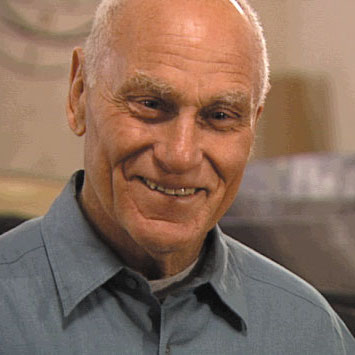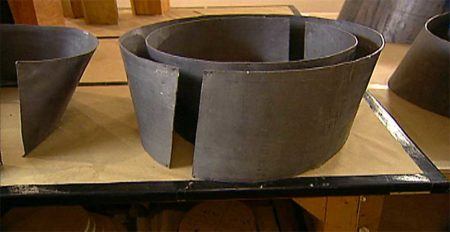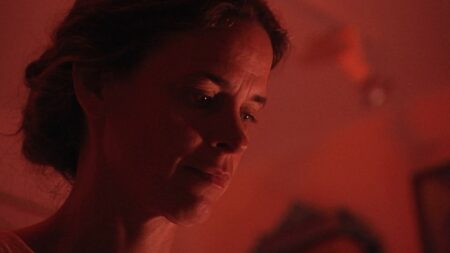Continue playing
(Time remaining: )
Play from beginning
Continue playing "{{ controller.videos[controller.getVideo(controller.currentVideo)].segmentParentTitle}}"
{{controller.videos[controller.getVideo(controller.currentVideo)].title}} has ended.
Richard Serra in "Place"
The segment follows Richard Serra as he guides the viewer through several massive installations he has done in New York, San Francisco, and Bilbao, Spain. Having worked with metal for the past forty years, Serra creates sculptures shape and stretch steel like rubber, carving intimate moments out of public spaces.
“I was surprised that people who had absolutely no information about sculpture were able to enter into these pieces,” says the artist. “The experience for them was fulfilling because, in some sense, it was startling, it was new, because they couldn’t locate themselves.”
Credits
Created by: Susan Sollins & Susan Dowling. Executive Producer & Curator: Susan Sollins. Executive Producer: Susan Dowling. Series Producer: Eve-Laure Moros Ortega. Associate Producer: Migs Wright. Production Coordinator: Laura Recht. Researcher: Quinn Latimer & Wesley Miller. Director: Catherine Tatge. Editor: Donna Marino. Director of Photography: Bob Elfstrom & Joel Shapiro. Additional Photography: John Chater, Ken Kobland, & Don Lenzer. Sound: Gautam K. Choudhury, Ray Day, Doug Dunderdale, Aldo Ferraris Hierro, Chris Kellett, Ramon Larrabaster, Juan A. Torres, Bill Wander. Assistant Camera: Matthew Gordon, Brian Hwang, Paul Marbury, Glen Piegari, Enrique Puig, & Kipjaz Savoie. Gaffer/Grip: Ned Hallick, Paco Mayo, & Pedro Villalon. Location Manager: Asier Bilbao; Michelle Fernandez Echebarre; & Hilda Frontanes-Suarez, Tropical Visions. Production Assistant: Steve Carrillo, Graham Gangi, Brent Hamilton, Gabriel Monts, Eric Pfriender, Orlando A. Rivera, & Scott Stevens. Animation Stand Photographer: Marcos Levy & City Lights. Assistant Avid Editor: Heather Burak & Matt Prinzig. Assistant to the Director: Rachel Connolly.
Introductory Segment | Director & Writer: Laurie Anderson. Cast: Laurie Anderson. Director of Photography: Joey Forsyte. Gaffer: Peter Boynton, John Roche. Grip/Swing: Kit DiBenedetto, Patrick J. Webb. Make-up: Brooke Hunyady. Props: Heather Dunbar, Ali Goldman, & Zhanna Gurvich. Editor: Melody London. Assistant Editor: John Kim. Tai Chi Music by: Oliver Shanti & Friends.
Creative Consultant: Ed Sherin. Art Design and Direction: Open, New York. Animation, Visual Effects & Compositing: Spontaneous Combustion. On-Line Editor: Don Wyllie & Frame:Runner NYC. Composer: Peter Foley. Music Supervisor: John Yaffé. Sound Editing: Margaret Crimmins, Greg Smith, & Dog Bark Sound. Sound Mix: Tony Volante & Soundtrack, New York. Post-Production Supervisor: Michael Weingrad & Keir Randall.
Artworks courtesy of: Margaret Kilgallen; Sally Mann; Barry McGee; Pepón Osorio; Richard Serra; Bernice Steinbaum Gallery; Deitch Projects; Edwynn Houk Gallery; & Ronald Feldman Fine Arts. Archival footage of Barry McGee courtesy of: Thomas Campbell.
Special Thanks: Anne C. Baker; Alison Beall; City Lights; Silvia Karman Cubina; Susan Delson; Escuela de Artes Plasticas; Goldenberg Family; Russell Hassell; Jenni Holder; Instituto De Cultura Puertorriquena; Bruce Mac Corkindale; The Mann Family; Margarita Moreno; Museo de Arte Contemporaneo de Puerto Rico; Museo de Arte de Puerto Rico; Chris Pullman; Tina Rosario and family; Tamberelli Video; Tropical Visions; UCLA Hammer Museum; Virginia Museum of Fine Arts; Darin Webb
Interns: Maytal Ahrony, Joyce Alcantara, Christina Darcy, Leslie Fritz, Johanna Goldfeld, Susannah Gust, Sage Lehman, Kelly McCoy, Genevieve Mercatante, Jeff Seelbach, & Stacy Wu.
Public Relations: Kelly & Salerno Communications. Legal Counsel: Albert Gottesman.
Major underwriting for Season 1 of Art in the Twenty-First Century is provided by Robert Lehman Foundation, PBS, National Endowment for the Arts, Corporation for Public Broadcasting, Rockefeller Brothers Fund, Agnes Gund and Daniel Shapiro, The Allen Foundation for the Arts, The Broad Art Foundation, The Jon and Mary Shirley Foundation, Bagley Wright Fund, The Rockefeller Foundation, The Andy Warhol Foundation for the Visual Arts, The Horace W. Goldsmith Foundation, and The Foundation-to-Life.
Closed captionsAvailable in English, German, Romanian, Italian, Japanese, Korean, Chinese, Italian
Through the Art21 Translation Project, multilingual audiences from around the globe can contribute translations, making Art21 films more accessible worldwide. Translate this video now.
Interested in showing this film in an exhibition or public screening? To license this video please visit Licensing & Reproduction.
Richard Serra was born in 1938 in San Francisco, California. He graduated from the University of California, Santa Barbara with a BA in English Literature in 1961, working at different steel mills to support himself during college. The artist later went on to receive a BFA in 1962 and an MFA in 1964, both from Yale University. In his work, Serra investigated the relationship between space, material, and movement. Through large-scale sculptures and site-specific installations, the artist manipulated mediums such as lead and steel to construct immersive geometric artworks that emphasize materiality and the relationship between the viewer and the spaces in which his works are installed.
“I was surprised that people who had absolutely no information about sculpture were able to enter into these pieces. The experience for them was fulfilling because, in some sense, it was startling, it was new, because they couldn’t locate themselves.”
Richard Serra





